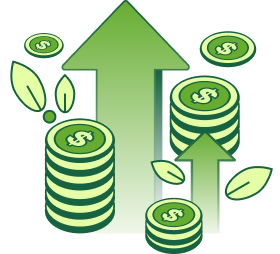Key takeaways
- A cash-out refinance replaces your mortgage and gives you a lump sum of cash, often with fixed interest and long repayment terms.
- A HELOC is a revolving line of credit that allows you to borrow as needed without changing your existing mortgage.
- Both options require sufficient home equity, low debt loads, and a minimum credit score of 620.
You can tap into your home’s value to borrow money for significant expenses, from home renovations to debt consolidation. Two ways to turn some of your equity into cash are home equity lines of credit (HELOCs) and cash-out refinances.
While both let you borrow against the equity you’ve built, they are distinct products. A HELOC is a type of second mortgage that allows you to borrow as needed for up to ten years. A cash-out refinance replaces your home loan with a new mortgage and lets you pocket the difference.
If you are considering borrowing against your home equity, understanding the difference can help you choose the best option. Here’s what you should know.
What is a cash-out refinance?
A cash-out refinance replaces your current mortgage with a new, larger one. You pay off the original mortgage and retain the difference to use as you see fit. For example, if your home is worth $400,000 and you owe $250,000 on your mortgage, you could refinance for $300,000. Then, you would get $50,000 in cash at closing.
The new mortgage comes with its own terms, often with a new interest rate and an extended loan term. It also increases your overall loan balance. You may end up with higher monthly payments and more interest paid over time.
Cash-out refinance requirements
To qualify for a cash-out refinance, you need a minimum credit score of 620. You may be able to refinance through FHA lenders with a lower score, but the higher your score, the better rates you’ll get. You’ll also need sufficient home equity, at least 20% after refinancing, and a debt-to-income ratio (DTI) below 50%.
Lenders often require a new appraisal of your property to determine its current value. Additionally, proof of stable income and employment is necessary to demonstrate your ability to repay the new loan.
Want more options for tapping into your equity?
What is a HELOC?
A HELOC is a type of second mortgage that does not affect your primary mortgage. With a HELOC, you borrow against the equity built in your home and receive a revolving line of credit, similar to a credit card. Your lender sets a credit limit based on your home equity, credit score, income, and other factors.
HELOCs are typically broken into two phases: the draw period (5-10 years) and the repayment period (10-20 years). During the draw period, you can borrow as needed, repay, and borrow again. You only make interest payments, but the interest rate can fluctuate.
After the draw period ends, you enter the repayment phase, where you pay back both principal and interest. During this phase, you can no longer borrow as needed, and your monthly payments usually increase significantly.
HELOC loan requirements
To qualify for a HELOC, lenders typically require at least 15%–20% equity in your home. Lenders generally require a minimum credit score of 680, although some may accept scores as low as 620. Higher scores improve your chances of approval and access to better rates.
You’ll also need a low DTI below 43% and a stable income to show you can manage payments. Most lenders will require a home appraisal to verify the value of your property. They will also ask for documentation of your employment, assets, and existing debts.
Difference between HELOC and refinance
The key difference between HELOCs vs. refinances lies in how you access your equity and repay the borrowed amount.
| Cash-out refinance | HELOC | |
| Home loan | New mortgage | Second mortgage |
| Funding | Lump sum at closing | Revolving line of credit during draw period |
| Repayment term | Revolving line of credit during the draw period | 5-10 year draw period; 10-20 year repayment period |
| Interest rate | Fixed or adjustable rates | Variable rates |
| Monthly payments | Predictable monthly payments | Interest-only payments during the draw period; principal and interest during the repayment period |
| Credit requirement | 620+; as low as 600 for an FHA refinance | 620-680 or higher |
| Home equity requirement | 20% | 15%-20% |
| DTI ratio | Less than 50% | 43% or lower |
| Closing costs | Pay fees upfront | Lower closing costs, or none at all |
HELOCs are best suited for ongoing expenses that require flexible access to cash. A cash-out refinance is best for one-time expenses or when you can take advantage of lower mortgage rates.
HELOC vs cash-out refinance: What do they have in common?
HELOCs and cash-out refinances both let you tap into your home’s equity to access cash. In both cases, you can borrow up to 80% of your home’s equity and use the money as you see fit.
Many people use them as . They offer large amounts of money at lower interest rates than personal loans, along with long repayment terms.
The low interest rate is because your home serves as collateral. If you default, you risk losing your property.
To qualify for either one, you need a decent credit score, sufficient equity (at least 15% to 20%), and a DTI below 43%.
HELOC or cash-out refinance: key factors to consider
Thoroughly consider and compare your options before borrowing, especially when the loan is tied to your home.
1. Loan terms
A cash-out refinance replaces your current mortgage with a new, larger one. You will typically receive a fixed interest rate and a new term of 10 to 30 years. This means you restart your mortgage repayment timeline, which can increase your total interest costs unless you pay it off early.
A HELOC is a separate second mortgage you pay in addition to your primary mortgage. It usually has a draw period of 5-10 years (interest-only payments), followed by a repayment period of 10-20 years.
2. Interest rates
Cash-out refinances typically have fixed or adjustable interest rates that are often lower than those of HELOCs since they’re first-lien loans. You may be able to secure a more favorable rate than your original mortgage.
HELOCs have variable interest rates that may fluctuate as the market changes. You may end up paying more interest.
3. Repayment flexibility
A cash-out refinance provides a lump sum upfront that you repay with fixed monthly payments. Repayments are less flexible, but predictable payments are easier to manage.
HELOCs have interest-only payments during the draw period. Only paying interest on what you spent can help you manage your cash flow. During the repayment period, you will have to pay both interest and principal until you pay off the line of credit.
4. Effect on credit score
A HELOC and a cash-out refinance will have the same impact on your credit. When you apply, the lender will conduct a hard inquiry. The inquiry may cause a slight dip and be the reason .
The drop is only temporary and can easily be overcome. Consistently pay on time, and your score will improve. Late or missed payments will damage your credit.
5. Tax implications
Both HELOCs and cash-out refinances offer tax benefits. You might be able to deduct the interest if you use the money for home improvements. These improvements should add value or extend the life of your home.
6. Fees and closing costs
Cash-out refinances typically come with closing costs, similar to those of a traditional mortgage. You must pay a fee of 2% to 6% of the loan amount upfront.
HELOCs typically have lower upfront fees and often no closing costs. Some lenders may charge annual fees or penalties for early closure.
Frequently asked questions
1. Is it better to refinance or get a HELOC?
It depends on your financial goals. A cash-out refinance may be a better option if you can get a lower fixed interest rate than your current mortgage. A HELOC can be a better choice if you need flexible access to funds or if you don’t want to reset your mortgage.
2. Do you have to refinance to get a HELOC?
You don’t have to refinance your mortgage to get a HELOC. A HELOC is a separate loan that’s secured by your home’s equity. It does not replace your existing mortgage, which stays intact.
3. Can I refinance a home equity loan?
You can refinance a home equity loan to secure a lower interest rate or change your repayment term. You may choose to refinance into a new home equity loan, a HELOC, or even combine it with your primary mortgage through a cash-out refinance. Lenders will evaluate your credit, income, and home equity before approving your loan.
4. Is a HELOC considered a second mortgage?
A HELOC is a second mortgage because your home secures it and comes in addition to your existing mortgage. Similar to a traditional second mortgage, it enables you to borrow against your home’s equity.
Bottom line
Cash-out refinancing and HELOCs enable you to convert equity into cash. You can access funds at a lower rate with more favorable terms. The right one for you depends on how you want to receive and repay the money.
If you prefer a single mortgage payment, plan to stay in your home for an extended period, and appreciate predictable monthly payments, then a cash-out refinance may be the right choice for you. Cash-out refinances are especially beneficial if you can qualify for better terms than your original mortgage.
A HELOC can be the right choice if you prefer a revolving line of credit and don’t know how much you’ll need to borrow. While they are flexible, interest rates can fluctuate and increase, driving up payments.
Carefully weigh your choices to make an informed decision. Borrowing against your home carries financial risk and shouldn’t be entered into lightly. Consult with a lender to determine the best choice for your situation and goals.




